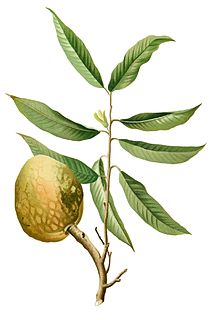
Annona is a genus of flowering plants in the pawpaw/sugar apple family, Annonaceae. It is the second largest genus in the family after Guatteria, containing approximately 166 species of mostly Neotropical and Afrotropical trees and shrubs.

Annona reticulata is a small deciduous or semi-evergreen tree in the plant family Annonaceae and part of the Annonas group. It is best known for its fruit, called custard apple, a common name shared with fruits of several other species in the same genus: A. cherimola and A. squamosa. Other English common names include ox heart and bullock's heart. In India, it is commonly known as Ramphal in Hindi and aater in Konkani. The fruit is sweet and useful in preparation of desserts, but is generally less popular for eating than that of A. cherimola.

Annona glabra is a tropical fruit tree in the family Annonaceae, in the same genus as the soursop and cherimoya. Common names include pond apple, alligator apple, swamp apple, corkwood, bobwood, and monkey apple. The tree is native to Florida in the United States, the Caribbean, Central and South America, and West Africa. It is common in the Everglades. The A. glabra tree is considered an invasive species in Sri Lanka and Australia. It grows in swamps, is tolerant of saltwater, and cannot grow in dry soil.

Annona purpurea is an edible fruit and medicinal plant in the Annonaceae family. It is native to Mexico, Central America, and parts of South America. Its common names include soncoya, sincuya, and cabeza de negro.

Annona montana, the mountain soursop, is an edible fruit in the Annonaceae family native to Central America, the Amazon, and islands in the Caribbean. It has fibrous fruits. A. montana may be used as a rootstock for cultivated Annonas.
Annona asplundiana is a species of plant in the Annonaceae family. It is native to Peru, Ecuador and Brazil. It is considered as a vulnerable species by the IUCN.
Annona conica is a species of plant in the Annonaceae family. It is endemic to Ecuador. Its natural habitats are subtropical or tropical dry forests and subtropical or tropical moist lowland forests. It is threatened by habitat loss. The maximum average height for a domesticated Annona Conica is around 300 cm and in the wild 500 cm.
Annona cristalensis is a species of plant in the Annonaceae family. It is endemic to Cuba.
Annona deceptrix is a species of plant in the Annonaceae family. It is endemic to Ecuador. Its natural habitat is subtropical or tropical moist lowland forests. It is threatened by habitat loss.
Annona deminuta is a species of plant in the Annonaceae family. It is endemic to Peru.
Annona ecuadorensis is a species of plant in the Annonaceae family. It is endemic to Ecuador. Its natural habitat is subtropical or tropical moist lowland forests. It is threatened by habitat loss.
Annona ekmanii is a species of plant in the Annonaceae family. It is endemic to Cuba.
Annona manabiensis is a species of plant in the Annonaceae family. It is endemic to Ecuador. Its natural habitat is subtropical or tropical dry forests. It is threatened by habitat loss.
Rollinia amazonica is a species of plant in the Annonaceae family. It is endemic to Colombia.
Rollinia fendleri is a species of plant in the Annonaceae family. It is endemic to Venezuela.
Rollinia pachyantha is a species of plant in the Annonaceae family. It is endemic to Colombia.
Rollinia pickelii is a species of plant in the Annonaceae family. It is endemic to Brazil.
Rollinia rufinervis is a species of plant in the Annonaceae family. It is endemic to Colombia.

Annona mucosa is a species of flowering plant in the custard-apple family, Annonaceae, that is native to tropical South America. It is cultivated for its edible fruits, commonly known as biribá, lemon meringue pie fruit, or wild sugar-apple, throughout the world's tropics and subtropics.
Annona haitiensis is a species of plant in the Annonaceae family. It is endemic to the Caribbean island of Hispaniola. Robert Elias Fries, the Swedish botanist who first formally described the species, named it after Haiti where the specimen he examined was collected.






